Kwok Wing Lam – Winnie (HK/BE) is a versatile designer based in Brussels, whose practices focus on social and community based design experiences. Winnie earned her first degree in Interior Architecture at l’école supérieure des Arts Saint-Luc Brussels, before obtaining her Masters in Humanitarian Design and Sustainable living at the Design Academy Eindhoven in the Netherlands.
This combined knowledge leads her into different area of design, from a scenography for UNRIC (United Nations Regional Information Centre) to an urban redevelopment project for the city of Brussels, not counting her passages to architecture firms and design studios.
In parallel to her practice as a designer, she managed numerous creative projects from local up to an European level: projects includes: ‘‘House Proud’, ‘The race to clean air’, ‘Human Cities Brussels’, ‘Human Cities Istanbul’. At the moment she is managing projet such as ‘Glass is Tomorrow II’, urbain art platform ‘No New Enemies network’ and she is co-partner of Brussels based contemporary art gallery, Harlan Levey Projects.
She earns a valuable experience in managing projects that deal with multidisciplinary networks, strategies for civil well being and development. While Winnie’s projects and history are diverse, but her approach on design and in general has always been attracted by people and in particular their well being.
Contrat de Quartier durable Jardin aux Fleurs – Sustainable neighbourhood contract “Jardin aux fleur / Bloemenhof 2011-2015”
Under the framework of Jardin aux Fleurs contract, the city commissioned local non-profit organization MAD (Fashion and Design Centre) and Recyclart Art Center to develop new street furniture to the square Jacques Brel involving designers and local residents.
Key actors
Main promoters: The City of Brussels, Brussels-Capital Region, Federal Public Service Mobility and Transport (Beliris)
Secondary players: Recyclart Art Center, MAD (Fashion and Design Center)
Beneficiaries: inhabitants and users of the area Square Jacques Brel
Role of Design
Design is used throughout the project. In particular, the participatory practices took an important part into the process.
The research phase includes two workshops that allowed the designers to identify, investigate, analyse and engage the public to participate on the square’s refurbishment.
The participatory probes (video, communication material: posters, stand…) were designed in a graphical and interactive way in order to attract and encourage the community (different age group) to imagine and vote for their ideal square Jacques Brel. (From functions, shapes, colours, activities to materials etc). As result, it provided great insight to the development of the final design.
CONTACT (of the editor)
Winglam Kwok – Organization: Pro Materia Association – Email: winglam@promateria.be
Since 2014, the Human Cities network has been working on Challenging the City Scale to question the urban scale and investigate cocreation in cities. The Human Cities partners have carried out urban experimentations in 11 European cities empowering citizens to rethink the spaces in which they live, work and spend their leisure time.
Challenging the City Scale, journeys in People-Centred Design is the final book of the project. Through conversations with people involved, the book examines how bottom-up processes and their design, tools and instruments generate new ideas to reinvent the city. It offers inspiration and insights to everyone, from practitioners and politicians to designers and active citizens, eager to try out new ways to produce more human cities together.
Title : Challenging the City Scale, Journeys in People-Centred Design
Collective book co-edited by: Olivier Peyricot, Josyane Franc, Frank Van Hasselt
Authors: Josyane Franc, Olivier Peyricot, John Thackara, Alice Holmberg, Côme Bastin, Fleur Weinberg, Anya Sirota, Frank Van Hasselt, Robin Houterman
Graphic design: Audrey Templier, Isabelle Daëron Language: English Publisher and distributor: Birkhäuser, Basel
Co editors : Cité du design (Saint-Etienne) et Clear Village (Londres) ISBN: 978-3-0356-1796-2 Format : 21,5 x 26 cm (vertical)– 176 p Price: 39.95 € Available in partner’s bookshops and bookshop distributed by Birkhäuser Open access digital version: https://www.degruyter.com/view/product/510323?format=EBOK
The printed version was launched on 4th May 2018 in Graz, during the event organized by FH JOANNEUM included in the programme of the Festival Design Month.
You can now download it in digital , open access version following this link:
01_human_cities_challenging_the_city_scale_2014-2018_investigation
The book “Investigation” is a collaborative research work, made from all the case studies collected by the partners in Europe publicated on this website. They tell about actions led by creative citizens to transform their urban environment. Researchers from Cité du design Saint-Étienne, the Department of Design of Politecnico di Milano and Urban Planning Institute of The Republic of Slovenia Ljubljana provide a state of the art of these initiatives. Analysing these multiple examples, they investigate how urban dwellers participate, get organized and collaborate with creative professionals to prototype more liveable cities.
This scientific work published by Cité du design Saint-Étienne is addressed to researchers, practitioners, but also developers or creative citizens.
It is both an object of Design research and an incentive to develop experimental and collaborative projects of urban transformation.
Title: Human Cities / Challenging the City Scale 2014-2018 / Investigation
Main authors:
Cité du design Saint-Etienne: Isabelle Daëron, Floriane Piat & Eléa Teillier
Design Departement, University Politecnico di Milano: Davide Fassi & Laura Galluzzo
Urban Planning Institute of the Republic of Slovenia, Ljubljana: Matej Nikšič, Nina Goršič & Biba Tominc
Language: English
Copyright © Cité du design, 2018
ISBN: 978-2-912808-79-0 . Format : 215×260 mm – 240 p – not sold – free distribution within the framework of Creative Europe Programme of the European Union 2014-2018
As cities organizations are facing major urban and technological transformations, European citizens are taking possession of their cities, collaborating or acting for its renewal. Which kind of tools are set up to think and produce the public space together? How to make these bottom-up initiatives sustainable?
Challenging the City scale 2014-2018 / Investigation is a collaborative research work of Human Cities project, made from more than 80 case studies collected by the partners in Europe. They tell about actions led by creative citizens to transform their urban environment. Researchers from Cité du design Saint-Étienne, the Department of Design of Politecnico di Milano and Urban Planning Institute of The Republic of Slovenia Ljubljana provide a state of the art of these initiatives. Analysing these multiple examples, they investigate how urban dwellers participate, get organized and collaborate with creative professionals to prototype more liveable cities.
This scientific work published by Cité du design Saint-Étienne is addressed to researchers, practitioners, but also developers or creative citizens.
Title: Human Cities / Challenging the City Scale 2014-2018 / Investigation Main authors: Cité du design Saint-Etienne: Isabelle Daëron, Floriane Piat & Eléa Teillier Design Departement, University Politecnico di Milano: Davide Fassi & Laura Galluzzo Urban Planning Institute of the Republic of Slovenia, Ljubljana: Matej Nikšič, Nina Goršič & Biba Tominc
Language: English Copyright © Cité du design, 2018 ISBN: 978-2-912808-79-0 . Format : 215×260 mm – 240 p – not sold – free distribution within the framework of Creative Europe Programme of the European Union 2014-2018
Since 1999, Pro Materia Association has developed through more than fifteen years of experience a recognized international design expertise, especially in the European Union ‘Culture’ programme, today known as Creative Europe. It has conceived innovative projects ‘from the scratch’ such as Human Cities on reclaiming public space through a human-centered approach of design (since 2006), and Glass is Tomorrow, on design-led crafts leading to reinvent glass art in Europe (since 2011). By creating cutting-edge concepts, which are highly human-driven and collaborative, Pro Materia is cultivating the art of putting people together within a framework, rather informal, freestyle and co-creative (workshops, creative labs, exhibitions…) By stressing the relationship between disciplines in the visual and applied arts and their cultural added value, the Brussels-based Creative Design Agency is moving forward, looking at the future, at the emerging and upcoming talents, curating events and editions with a high sense of quality and awareness towards artistic contents.
Plein OPENair Festival
Plein OPENair is founded by Cinema Nova who is run by a collective of volunteers since 1997.
This movie theatre screens mainly independent and undistributed film in Brussels. Stemmed from the desire to go beyond the traditional location and to reach a bigger public gave birth to the project Plein OPENair. It is an annual urban festival held in the city of Brussels three weekends every summer since 1997.
Organised by local associations Cinema Nova and City Mine(d), they attempt to generate critical public awareness of buildings threatened by demolition, or abandoned sites in need of development through a series of open-air film screenings.
Plein OPENair festival plants its screen like a flag, they look to the city’s changes led by politicians, landowners, architects and construction companies, then choose locations to show films that are symbolic of those changes. As a result, it creates opportunities to build bridges with other actors while developing creative practices and expression in public space. In doing so, it deconstructs the codes imposed by a top down urban development to make room for citizen’s imagination and involvement.
Each year the festival sets a site-specific theme that provides the framework for the screening. Themes from ‘the privatisation of public space’, ‘insecurity’ to ‘sustainable city’… In parallel, a wide range of urban cultural and artistic activities like debates, guided walks, music, performance, radio show are organized to accompany the programme.
Access to all activities is always free, which is made possible both by subsidies and the support of volunteers.
Key-actors
Organizer: Cinema Nova and Citymine(d)
Secondary players: Volunteers
Beneficiaires: local residents (young people to seniors), local authorities
Role of design
The use of design is implicit. But we notice that Plein OPENair’s mode of operation involves design methodology and processes. They catalyse citizens to see issues and possibilities through an open-air cinema. Such methodology stimulates and tackles complex urban issues in a creative and approachable way.
CONTACT (of the editor)
Winglam Kwok – Organization: Pro Materia Association – Email: winglam@promateria.be
Parvis de Saint-Gilles – The Saint-Gilles Esplanade
In June 2013, the Mayor of the Municipality of Saint-Gilles and its Urban Planning department decided to transform the so-called The Saint-Gilles Esplanade into a pedestrian area. Parallel to this political decision it has been voted a call for projects in order to renew and reclaim the potential public space area, which was potentially there but needed to be transformed. The local public authorities went through a long process of selection to finally decide in Spring 2014 to select the project of the Brussels-based landscape architecture Bureau Bas Smets. From 4 to 7 September 2014 from 10 am until 6 pm, the inhabitants and citizens of the municipality were invited to discover the final project of the future The Saint-Gilles Esplanade by following the full process of conception, transforming the existing multifaceted land into a homogeneous and liveable urban landscape, mixing the functions of the church, the cafés and restaurants as well as the marketplace. The sketches, which were presented to the population have started to be discussed by the people involved in the neighbourhood, at a local and regional level, in order to respond as best as possible to the new expected usages. This ongoing process has entered in May 2015 in its second phase knowing that there is still an issue related to the replanting of the trees on the esplanade that Bas Smets suggests to move to another square down to the esplanade as well as around the church that is at the top of the hill. This coherent approach is much motivated by the state of the trees which need to be replaced for some of them in order to re-create an urban land-scape on the piazza but also on the public squares at the top of and down the hill.
Key-actors
The municipality of Saint-Gilles including the Mayor of Saint-Gilles and his City Planner, the Brussels Capital Region, the municipality’s inhabitants, the shopkeepers, the owners of cafés and restaurants, the church.
Role of design
The users are involved at all levels of this project, which is targeting new usages to be developed to respond to inhabitants’ needs in the neighbourhood. Some additional functions have been added to the public space: a moveable urban lighting system in order to ease the organization of temporary events and festivals on the long free-walk square. The re-use of the blue stone coming from the existing pavement on the square has allowed Bureau Bas Smets to design the lines to delimit the functions in the urban space, which adds on a contemporary and singular identity to the new piazza and ease the re-organisation of the cafés, restaurants and marketplace on the redesigned esplanade.
CONTACT (of the editor)
Lise Coirier – Organization : Pro Materia – Email : lise@promateria.be
The printed version was launched on 4th May 2018 in Graz, during the event organized by FH JOANNEUM included in the programme of the Festival Design Month.
You can now download it in digital , open access version following this link :
01_human_cities_challenging_the_city_scale_2014-2018_investigation
The book “Investigation” is a collaborative research work, made from more than 80 case studies collected by the partners in Europe. They tell about actions led by creative citizens to transform their urban environment. Researchers from Cité du design Saint-Étienne, the Department of Design of Politecnico di Milano and Urban Planning Institute of The Republic of Slovenia Ljubljana provide a state of the art of these initiatives. Analysing these multiple examples, they investigate how urban dwellers participate, get organized and collaborate with creative professionals to prototype more liveable cities.
This scientific work published by Cité du design Saint-Étienne is addressed to researchers, practitioners, but also developers or creative citizens.
It is both an object of Design research and an incentive to develop experimental and collaborative projects of urban transformation.
A second book – addressed to a more general audience – will be released in September 2018 and presented in Tallinn during the Desainiöö festival.
Louisa Vermoere is communication coordinator of Human Cities/ Challenging the City Scale 2014-2018. She has her own practice as a strategic & architectural designer, graduated at Sint-Lucas Gent – Luca | School of Arts in 2008 and Strelka Institute, Moscow in 2015. She has been co-developing several participative projects addressing public issues aiming for resilient solutions & strategies within multidisciplinary collaborations. Her projects can often be considered soft urbanism that tries to reconnect (im)material streams considered as redundant or hidden. She is cofounder of POOL IS COOL, Collective Disaster, No time No space.
Her collaborations and research has been exhibited, installed and presented world wide. Temple of Holy Shit received the 2nd Prize of the GCSM Blue Responsibility Award, was designed for Parckfarm Turn and Taxi, Parckdesign 2014, Brussels and exhibited in the Onassis Cultural Center in Adhocracy 2015, Athens – Issue of tissue exhibited at «Second Hand Second Life» expo 2013, Petits Riens, Brussels – Bxl Swings in the Cracks was presented in Pop-up City Life, Beurschouwburg, Brussels 2014 – Collective Disaster expressed its intentions at «The Collective Intention» 2015, Depot Basel – Research based design on Shrinking Cities was exhibited in «BIG FUTURE» expo, at the Strelka Institute for Media, Architecture and Design, 2015 Moscow – Holy Shit Preacher drove around at «PERIFERIA Festival» 2015 organised by CITY 3, Brussels. The Miracle Mountain has been installed at «Festival des Hortillonnages 2016» in Amiens.
Lise Coirier has set up Pro Materia as her Creative Design Consultancy Agency in 1999. She is founder and editor‐in‐chief of TL Magazine since 2009 and has launched EU cultural-driven projects such as Human Cities in 2007 and Glass is Tomorrow in 2011. Her background as author and curator of art and design projects, books and exhibitions has driven her for more than fifteen years into the promotion and development of the creative industries in Belgium and at an international level.
Les Apéros Urbains -Aperos Urbains
Started with 40 participants, today an average of 2.500 people joins the Apéros Urbains every Friday in a new area of Brussels to enjoy an after work drink.
There was not much nightlife in Brussels in 2004 when François Lafontaine and Viriginie Cwajagenbaum had the idea of organizing a drink on a Friday night in a public space. They wanted to re-appropriate public spaces where people do not necessarily accustomed to and to create opportunities for people to meet in a relaxed atmosphere after work.
The first event was organized in 2005 with the support of social media and 25 people came. Today, this informal activity has grown up to 37.800 followers on their Facebook group. They have changed from an underground and illegal outdoor event to a non-for-profit organization working closely with the local municipalities and other local collective actors.
The Apéros Urbains is held every Friday during summer starting on the 30th of May from 19:00 to 23:00 in various locations around Brussels.
Key-actors
Founder: François Lafontaine and Virginie Cwajgenbaum
Secondary player: Municipalities of Brussels-Capital Region, a group of volunteers, sponsors
Beneficiaries: The general public, the municipalities, sponsors and the organizers
Role of Design
One of the keys to their success is the use of technology and social platform (such as Facebook, Twitter) in their communication strategy. The social network plays a major role in the promotion of the project; they have an extensive network of followers on their FB page. Moreover, people who join the new edition of Apéros Urbains receive a smart card inserted into a terminal. Information will return on that person’s Facebook profile to notify friends. Another technological innovation is a smartphone app who geolocate and find the person’s friends within the site of Apéros Urbains.
CONTACT (of the editor)
Winglam Kwok – Organization: Pro Materia Association – Email: winglam@promateria.be
La Fête des Voisins – Neighbours’ Day
The idea of Neighbours’ Day was born in 1990 by Atanase Périfan. The story started in 1997, an elderly woman’s body was found in her Parisian flat four months after she died. Atanase was moved by this tragedy that he started to commission a survey asking one question: ‘What makes an ideal neighbour?’. The popular answer was ‘A neighbour you never see’. This lack of community spirit, mutual aid among neighbours answer pushed Atanase to create the initiative ‘Immeubles en Fête’ known today as ‘La Fête des Voisins’.
How?
Neighbour’s Day is an annual event that occurs at the end of May. Any city or social housing organization is welcome to participate in Neighbour’s Day by promoting the event with the inhabitants using all the communication means at their disposal. It is then up to each resident or group of residents to organise their own parties.
Key-actors
City residents
Institutional partners: City of Brussels, Visit Brussels, and National lottery, Federal Urban Policy
Role of design
Design is used in the communication and dissemination of the project.
Materials such as posters, flyers, communication kits are free and downloadable on the site.
CONTACT (of the editor)
Winglam Kwok – Organization: Pro Materia Association – Email: winglam@promateria.be
The book arrived freshly printed in Ljubljana on 20th April and it will be launched in Graz on 4th May 2018.
After a great work of case studies collection by all the Human Cities partners, a deep process of analysis by Cité du design, Politecnico di Milano and UIRS, and a nice graphic design elaboration by Audrey Templier, the scientific publication of Human Cities-Challenging the City Scale is released.
Its title: Human Cities / Challenging the City Scale 2014-2018 / Investigation
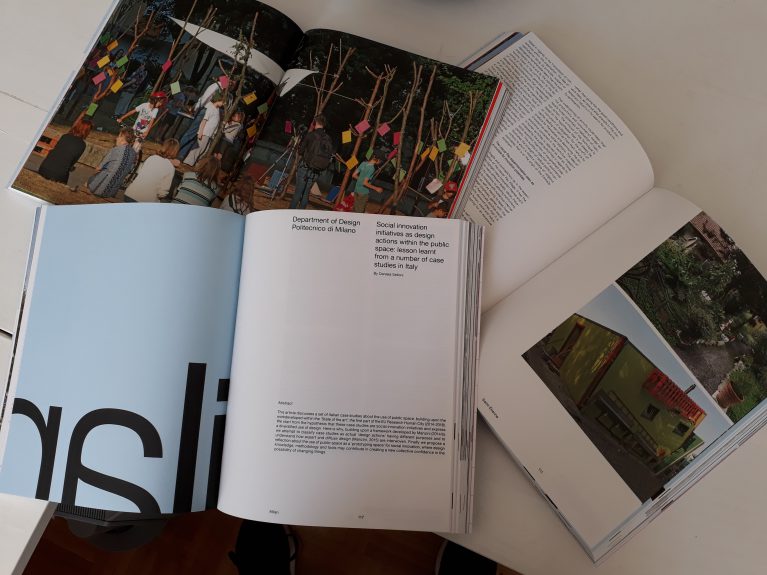
Glimpse of the book, fresh from the print shop in Ljubljana
As cities organizations are facing major urban and technological transformations, European citizens are taking possession of their cities, collaborating or acting for its renewal. Which kind of tools are set up to think and produce the public space together? How to make these bottom-up initiatives sustainable?
This Investigation is a collaborative research work, made from more than 80 case studies collected by the partners in Europe. They tell about actions led by creative citizens to transform their urban environment. Researchers from Cité du design Saint-Étienne, the Department of Design of Politecnico di Milano and Urban Planning Institute of The Republic of Slovenia Ljubljana provide a state of the art of these initiatives. Analysing these multiple examples, they investigate how urban dwellers participate, get organized and collaborate with creative professionals to prototype more liveable cities.
This scientific work published by Cité du design Saint-Étienne is addressed to researchers, practitioners, but also developers or creative citizens.
A large space is dedicated to images, to illustrate concretely this multiple initiatives, all linked by the sense of human scale and collaborative activities.
Our Investigation is both an object of Design research and an incentive to develop experimental and collaborative projects of urban transformation.
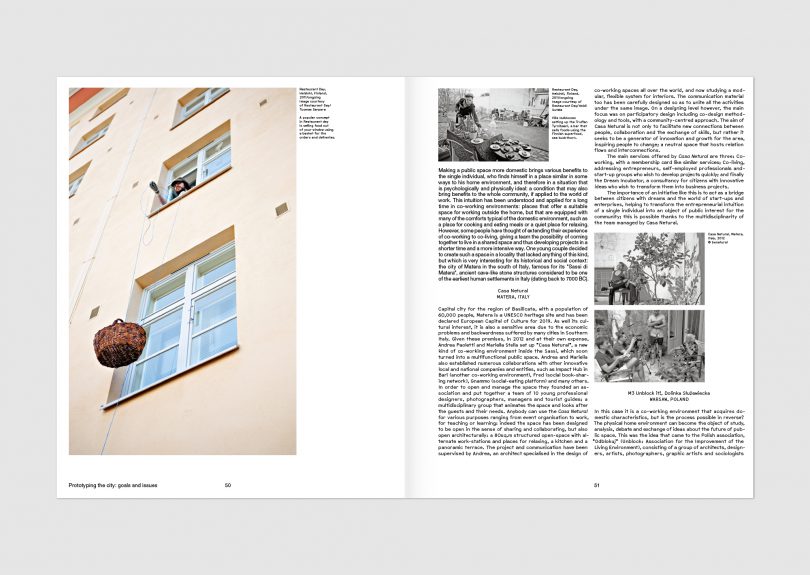
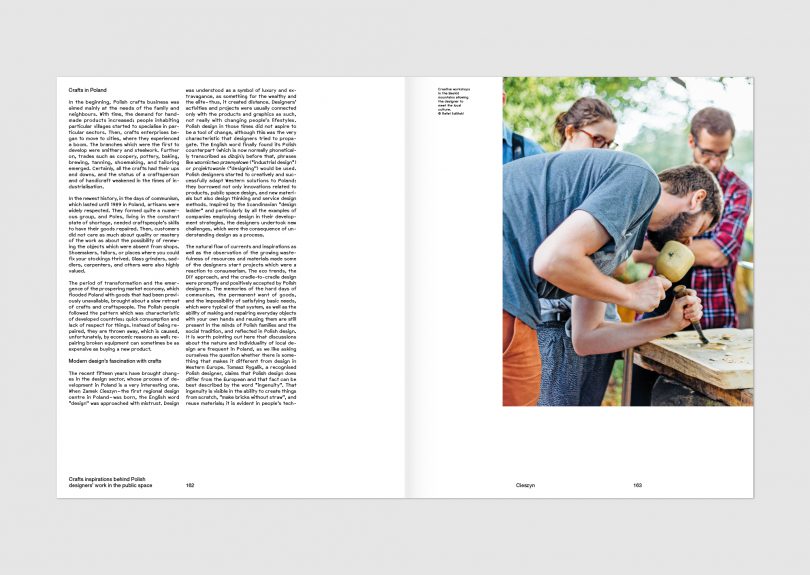
The book will be launched on 4th May in Graz for the 10 th festival Design Monat, during the event organized by FH JOANNEUM in presence of all the European partners of the programme. From this day, it will be available in digital version on the Human Cities project website – Case Studies section- and Cité du design Saint-Étienne website – publication section.
This is one of the common productions of the European project Human Cities_Challenging the City Scale . Together the partners will have produced 10 urban experiments in the various partner cities ; an exhibition-lab programmed in the main European Design festivals (next steps: Graz, Design Monat : 4thMay-24th June 2018 and Tallinn, Disainiöö: 10th– 16th September 2018) ; 11 international workshops ; masterclasses ; conferences ; and a final book narrating this experience (released in September 2018).
One of the most important outcomes of the previous Human Cities festival in 2012/ Reclaiming public space was the development of a Toolbox. The Toolbox is a collection of tools or toolkits, developed to let people take action in their cities or neighbourhoods. The Toolbox was conceived under the direction of Politecnico di Milano and Cité du Design and coordinated by Strategic Design Scenarios.
The design and concept for this app – which will be available to download from April 2016– was developed by three creative minds from Graz. Miriam Derler, Andrea Hutter and Miriam Weiss, all of them master students of Communication Design at the University of Applied Sciences, designed an interactive exhibition catalogue where users stand in the spotlight. The main idea was to create a catalogue, which you can not only browse but also be part of yourself. Therefore, all visitors of exhibitions have the possibility to upload their pictures, videos and remarks, which can then be seen in the app and on video screens in public space. In addition, a scan function allows participants to retrace authors of pictures as well as to leave comments. So everybody can be part of the app and the whole Human Cities Community. Due to this fact, a good mix of many different perspectives from various people can arise since everybody has a different design approach. With this app, the three designers successfully managed to connect the digital with the real world.
So participate yourself! Download the app in April and enjoy!
On 13th September 2018 , during the final event of Human Cities_Challenging the City Scale in Tallinn, happy partners launched a very important common production : the human cities 2014-2018 project book : Challenging the City Scale, journeys in People-Centred Design.

This 176 pages book is released by the famous international publisher Birkhäuser, and co-edited by Cité du design Saint-Etienne and Clear Village London, with the contributions of all the partners and invited authors. After a 1st publication oriented on research and inspirational case studies, this final book is the story of our experiences and cooperation addressed to a large audience of people interested in urban design and practices .
Since 2014, the Human Cities network has been working on Challenging the City Scale to question the urban scale and investigate cocreation in cities. The Human Cities partners have carried out urban experimentations in 11 European cities empowering citizens to rethink the spaces in which they live, work and spend their leisure time. Through conversations with people involved, the book examines how bottom-up processes and their design, tools and instruments generate new ideas to reinvent the city. It offers inspiration and insights to everyone, from practitioners and politicians to designers and active citizens, eager to try out new ways to produce more human cities together.
Our project can be seeen as a journey in people-centred design.
To prepare it, we asked Alice Holmberg, a designer and co-creation expert, to help each partner start their experiment through co-creative sessions. She explains in her article her approach to participatory design, and how she established a co-creation framework that was applied in a variety of contexts.
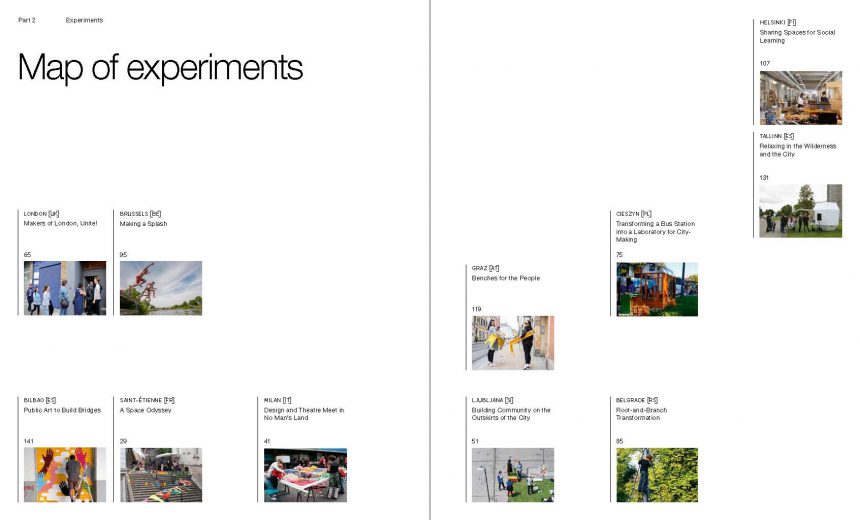
After the co-creative sessions, each partner departed on their own journey. For example, our partners in Saint-Étienne, Graz, Bilbao, Helsinki and London worked with citizens to turn vacant or
underused spaces into test sites for new solutions for work, service provision, education and communication. In Ljubljana, Belgrade, Cieszyn, Tallinn, Brussels and Milan, our partners joined forces with citizens to contribute to the development of a neighbourhood through improving the quality of public spaces. We invited two journalists, Côme Bastin and Fleur Weinberg, to capture the stories of the experiments in each of the 11 partner cities. These stories compose the main part of this book.
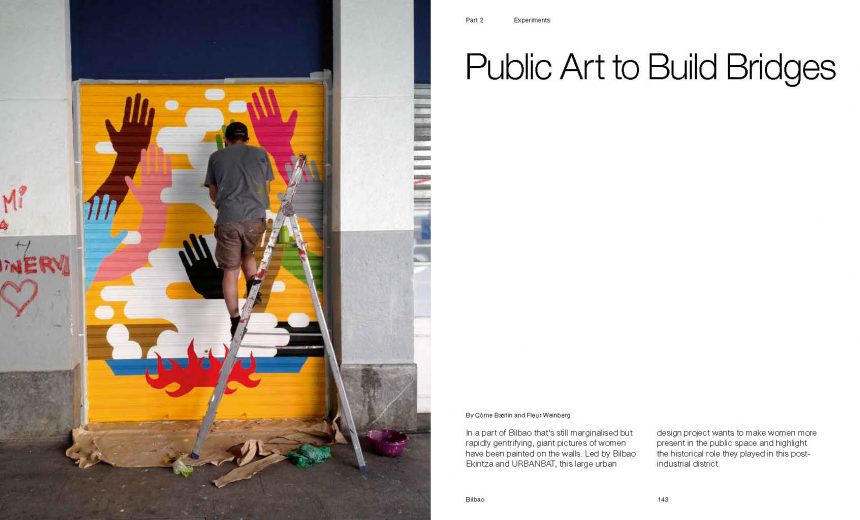
The variety of experiments allowed us to learn from each other. It also gave some hints for citizens, designers, and decision makers (insitutions and developers) which would like initiate that kind of actions. These learnings are shared in the third part of the book, written by Robin Houterman from a collective reflection led by all the partners.
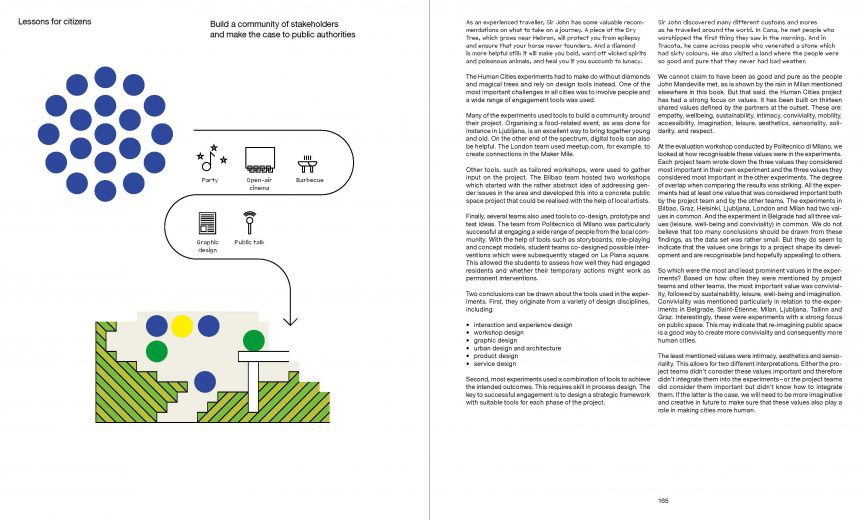
We asked two urban experts to provide a context for our stories. John Thackara, a writer-philosopher, explains the importance of understanding the notion of the city “as a living system”. His chapter emphasises the need to take care of our commons, a term that includes the spaces, memories, knowledge, skills, culture and biodiversity that we all share.
Anya Sirota, founder of and architect at Akoaki, shares with us her experiences from Detroit, USA. In a context of severe urban decline, Akoaki designs architectural interventions, art objects,
and social environments that aim to make an impact far beyond their physical appearances.
As a conclusion – or an introduction to the next journeys to come – Olivier Peyricot and Josyane Franc re-question the topic of bottom-up initiatives in the global context of city making. Could active citizen be the sole driving forces of the tranformations in contemporary cities? How to collectively take responsibility and act for the global challenges facing our urban societies ?
Since its start, the Human Cities project has led to a network of “Human Citizens” distributing their knowledge and skills across Europe, and beyond as well by making use of the network of UNESCO Creative Cities of Design. By writing this book, we hope to expand this network of Human Citizens even further. We hope that by sharing our enthusiasm and experiences, the book will be an inspiration and a valuable reference for those inclined to become involved themselves. Moreover, we want to convince policy and decision makers of the value of these initiatives and inspire them to take action to facilitate them better in the future.
Both Italian and Swedish nationality, he is graduated in archaeology and art history, specializing in the preservation and valorization of architectural heritage (Université Libre de Bruxelles). Based in Brussels, he currently works as a consultant on cooperation projects and programs in the fields of creative industries and cultural heritage for the European Commission and other national and international organizations. He is among the co-founder and executive manager of Culture Lab, a Belgian consulting agency specialized in the design and management of European and international cultural cooperation projects and in communication and public outreach strategies. In this capacity, he has carried out many consultancy missions, field studies and assessments of projects and programs in Europe, in Africa and in the Mediterranean area. Gian Giuseppe Simeone also has to his credit numerous studies and publications in the fields of cultural heritage and creative industries.
Human Cities Network, today, shares the purpose of the Toolbox which is one of the most important outcomes of the previous Human Cities festival in 2012/ Reclaiming public space. The Toolbox is a collection of tools or toolkits, developed to let people take action in their cities or neighbourhoods. The Toolbox was conceived under the direction of Politecnico di Milano and Cité du Design and coordinated by Strategic Design Scenarios. Human Cities took the opportunity to interview Francois Jégou of Strategic Design Scenarios to find out more about his strategies and developments of his more recent projects. What we found out was remarkably familiar to the purpose and strategy of the Human City Project today.
This Interview is the result of a brief contact over the phone between Louisa Vermoere and Francois Jégou on Friday 5 February.
Culture Lab, founded in 2002, is a private agency based in Brussels, providing European and international expertise in the areas of culture and heritage. The agency implements a wide range of missions, from the design and management of transnational cooperation projects, the assessment of cultural schemes and programs, the writing of sectorial studies, to public outreach, communication and dissemination activities, mainly in Europe, the Mediterranean area and Africa. In addition, Culture Lab Editions publishes specialized books on heritage and cultural creation. The company has collaborated and forged partnerships with key institutions and public and private organizations dealing with creative industries and the preservation and promotion of cultural heritage at a European and international level. In 13 years of activity, Culture Lab has contributed to the design, management and implementation of over 50 European and international cooperation projects and programs in the fields of contemporary cultural creation (visual arts, design , performing arts… ) and the conservation , restoration, management and promotion of tangible and intangible cultural heritage (architecture, archaeology , museums, crafts, traditions… ). Building on its experience in the previous Human Cities projects, the agency will provide technical assistance in the management of this larger scale cooperation project as well as in the communication and dissemination activities.
Brussels, Thursday 4 February 2016.
Before we accelerate HUMAN CITIES 2015-2018, Challenging the City Scale, we let you (re)discover a snapshot of the past through the eyes of the oldest partners. The Human Cities project and network was initiated by Pro Materia in Brussels in 2006 and has now spread in different cities all over Europe. To find out more about the past I, Louisa Vermoere, interviewed three ‘historic’ partners: Researcher Laura Galluzzo and Prof. Davide Fassi at the Polimi Desis Lab of the Politecnico di Milano, Matej Nikšič of UIRS: Urban Planning institute of the republic of Slovenia in Ljubljana and Camille Vilain of Cité du design in Saint-Etienne.